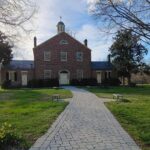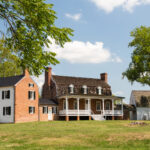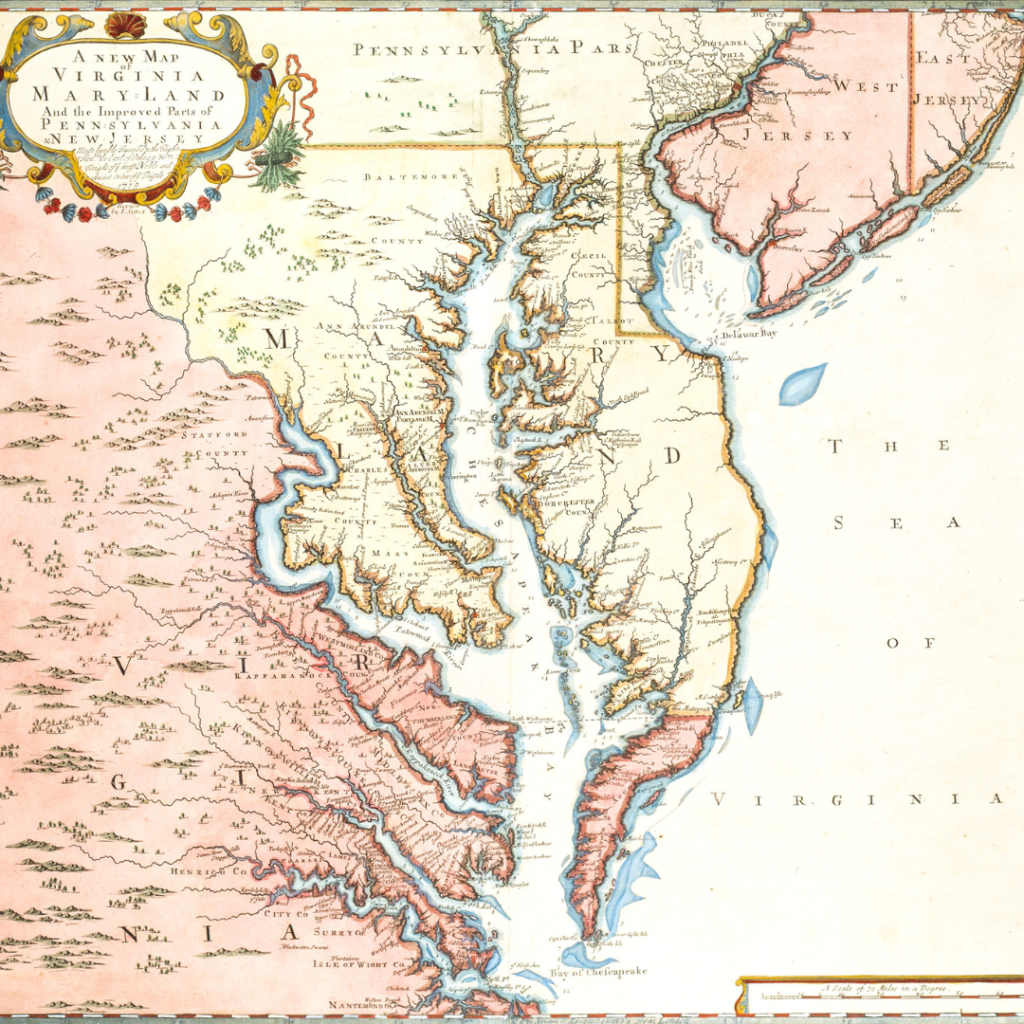 There is so much history near our house in Maryland. Pulling out of our neighborhood, to the right lay the ruins of Marshall Hall, the home of William Marshall, constructed in 1725. From the grounds, I can look across the Potomac River at Mount Vernon, the home of Marshall’s friend, George Washington. Turning left and driving a short distance, I pass the home of Thomas Stone, a signer of the Declaration of Independence. Further along is the colonial town of Port Tobacco Village. With a population of 13 in the 2010 census, it is the smallest incorporated town in Maryland. While the village is not much more than a crossroads today, it provides a fascinating chapter in American history.
There is so much history near our house in Maryland. Pulling out of our neighborhood, to the right lay the ruins of Marshall Hall, the home of William Marshall, constructed in 1725. From the grounds, I can look across the Potomac River at Mount Vernon, the home of Marshall’s friend, George Washington. Turning left and driving a short distance, I pass the home of Thomas Stone, a signer of the Declaration of Independence. Further along is the colonial town of Port Tobacco Village. With a population of 13 in the 2010 census, it is the smallest incorporated town in Maryland. While the village is not much more than a crossroads today, it provides a fascinating chapter in American history.
EARLY SETTLEMENT
Prior to the arrival of Europeans, indigenous people of the Algonquian Nation inhabited the area, primarily the Potopac (sometimes spelled Potapoco) and Piscataway tribes, which practiced agriculture, hunting, and fishing. The location along the river allowed them to move around easily for trade amongst other tribes. Archaeologists discovered finds dating back 5,000 years to the late Archaic  period. Quartz, quartzite, and rhyolite points (spear and arrow tips) were found. Test pits dug in 2007 discovered a small Native settlement from the Late Woodland period (900-1650 AD), which overlaps with the early European contact in the 1640s. Earthenware pottery shards containing crushed shells and sand have been found. Designs from imprinting the outside using cords, nets, or fabric have been identified throughout the Woodland periods.
period. Quartz, quartzite, and rhyolite points (spear and arrow tips) were found. Test pits dug in 2007 discovered a small Native settlement from the Late Woodland period (900-1650 AD), which overlaps with the early European contact in the 1640s. Earthenware pottery shards containing crushed shells and sand have been found. Designs from imprinting the outside using cords, nets, or fabric have been identified throughout the Woodland periods.
CONTACT PERIOD
Within a generation of English settlers arriving at St. Clement’s Island, people began pushing their way up the Potomac and Potopac Rivers. In 1634, frontiersmen established a small village on the east side of the Potopaco tributary consisting of taverns and residences, which they called Chandlers Town. It quickly became a nucleus for trade and government in the new colony. In 1658, it was designated the county seat of the newly formed Charles County. It was around this time that the English adapted the name Potopac into Port Tobacco, the crop that became their chief export. As a major player in the tobacco trade, Port Tobacco grew into the second largest port in Maryland, with its access to the Chesapeake Bay.
frontiersmen established a small village on the east side of the Potopaco tributary consisting of taverns and residences, which they called Chandlers Town. It quickly became a nucleus for trade and government in the new colony. In 1658, it was designated the county seat of the newly formed Charles County. It was around this time that the English adapted the name Potopac into Port Tobacco, the crop that became their chief export. As a major player in the tobacco trade, Port Tobacco grew into the second largest port in Maryland, with its access to the Chesapeake Bay.
 Many early settlers fled England to escape religious turmoil. In 1641, Father Andrew White established a Jesuit mission and later built a church on what is now Chapel Point. The small chapel was enlarged into St. Ignatius Church as the population grew. Today, it is considered the oldest continuously operating Catholic church in the United States. In its early days, the parish records show it was a center for local natives who converted to Christianity, while county records merely identified people of color regardless of origin.
Many early settlers fled England to escape religious turmoil. In 1641, Father Andrew White established a Jesuit mission and later built a church on what is now Chapel Point. The small chapel was enlarged into St. Ignatius Church as the population grew. Today, it is considered the oldest continuously operating Catholic church in the United States. In its early days, the parish records show it was a center for local natives who converted to Christianity, while county records merely identified people of color regardless of origin.
With the Toleration Act of 1649, other settlers in need of spiritual guidance formed the first Anglican congregation at the head of Port Tobacco Creek in 1683. With a tobacco poll tax of 40 pounds per head, Christ Church prospered from 1692 to 1776. As the congregation grew, a second structure was built in 1709. Following the American Revolution and the disestablishment of the Anglican Church, parishioners rallied and paid directly to Christ Church, and Lemuel Wilmer, an Episcopal cleric, served as rector for 35 years.
 For two centuries, the port town thrived and played an essential role in the emerging country’s history. Local man John Hanson was elected the first President of the Continental Congress. Thomas Stone was one of four Marylanders to sign the Declaration of Independence.
For two centuries, the port town thrived and played an essential role in the emerging country’s history. Local man John Hanson was elected the first President of the Continental Congress. Thomas Stone was one of four Marylanders to sign the Declaration of Independence.
DECLINE
Because of the erosion caused by excessive agricultural practices and poor soil conservation methods, the Port Tobacco River began to silt over. Decreasing navigability saw fewer ships able to make it up the river, and ultimately, the town was cut off from the Chesapeake Bay and the Atlantic Ocean shipping. Soil testing done in 2008 around the Native artifacts located beneath the more recently deposited sediment revealed that the valley did not experience significant siltation in the pre-Contact era.
The Civil War also was not kind to the town, causing further decline. Although under Union control, Port Tobacco was a hotbed of Confederate sympathizers, including the renowned Confederate spy Rose O’Neal. After the war, local enslaved people were freed following Maryland’s adoption of a new Constitution in 1864, further affecting the tobacco industry. The earlier Emancipation Proclamation did not apply to states that had remained in the Union. Finally, in 1895, the seat of Charles County, as well as Christ Church, moved to the nearby town of La Plata. Except for a few residents who remained, the village lay abandoned.
Today, the site is an active dig examining the town and the indigenous people who lived on the site. The restored courthouse (1819), Stagg Hall (1766), Burch House (mid-18th century), and a 19th-century one-room schoolhouse still stand in the town. Nearby is the 18th-century Thomas Stone National Historic Site. And, of course, Rose Hill, the site of a local legend.
 LEGEND
LEGEND
Just up the road is Rose Hill, an 18th-century manor house. On Halloween, local children celebrate the Legend of the Blue Dog, a giant beast who protects the treasure of his murdered master. During the late 18th century, Charles Thomas Sims, a soldier of the American Revolution, was returning home from a tavern in Port Tobacco. Henry Hanos, a local man, murdered Sims and his dog and took his gold and the deed to the property. He quickly buried them underneath a large stone near a holly tree until the furor over the murder died down. However, when he went to retrieve the stolen items, he found the stone guarded by the ghost of Blue Dog. In fright, he fled the scene and shortly thereafter died suddenly. Blue Dog continues to watch over the treasure of his slain master to this day.
Who says history can’t be fun?

Another great article Carol. As always very informative and enlightening.
Thanks, Dave!